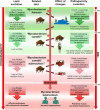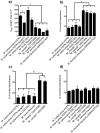The role of hydrophobicity in tuberculosis evolution and pathogenicity
- PMID: 28465507
- PMCID: PMC5431016
- DOI: 10.1038/s41598-017-01501-0
The role of hydrophobicity in tuberculosis evolution and pathogenicity
Abstract
The evolution of tubercle bacilli parallels a route from environmental Mycobacterium kansasii, through intermediate "Mycobacterium canettii", to the modern Mycobacterium tuberculosis complex. Cell envelope outer membrane lipids change systematically from hydrophilic lipooligosaccharides and phenolic glycolipids to hydrophobic phthiocerol dimycocerosates, di- and pentaacyl trehaloses and sulfoglycolipids. Such lipid changes point to a hydrophobic phenotype for M. tuberculosis sensu stricto. Using Congo Red staining and hexadecane-aqueous buffer partitioning, the hydrophobicity of rough morphology M. tuberculosis and Mycobacterium bovis strains was greater than smooth "M. canettii" and M. kansasii. Killed mycobacteria maintained differential hydrophobicity but defatted cells were similar, indicating that outer membrane lipids govern overall hydrophobicity. A rough M. tuberculosis H37Rv ΔpapA1 sulfoglycolipid-deficient mutant had significantly diminished Congo Red uptake though hexadecane-aqueous buffer partitioning was similar to H37Rv. An M. kansasii, ΔMKAN27435 partially lipooligosaccharide-deficient mutant absorbed marginally more Congo Red dye than the parent strain but was comparable in partition experiments. In evolving from ancestral mycobacteria, related to "M. canettii" and M. kansasii, modern M. tuberculosis probably became more hydrophobic by increasing the proportion of less polar lipids in the outer membrane. Importantly, such a change would enhance the capability for aerosol transmission, affecting virulence and pathogenicity.
Conflict of interest statement
The authors declare that they have no competing interests.
Figures



References
-
- Minnikin, D. E. et al. Pathophysiological implications of cell envelope structure in Mycobacterium tuberculosis and related taxa. In Tuberculosis - Expanding Knowledge (ed. Ribón, W.) 145–175 (InTech Open Access Publisher, Rijeka, 2015).
Publication types
MeSH terms
Substances
Grants and funding
LinkOut - more resources
Full Text Sources
Other Literature Sources
Medical

